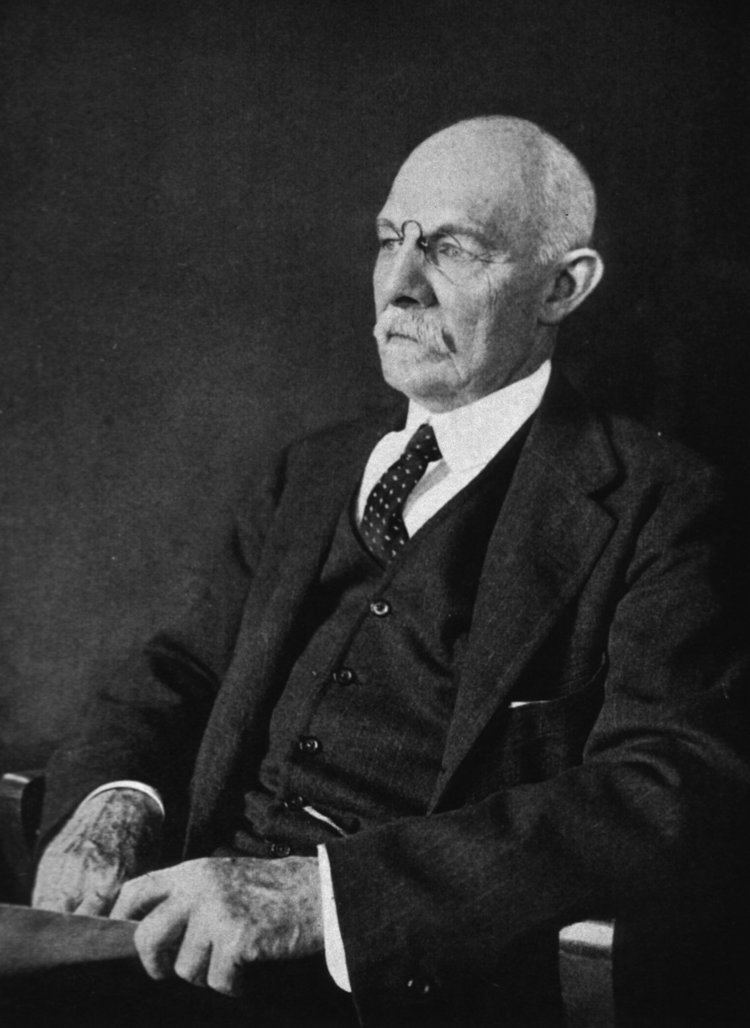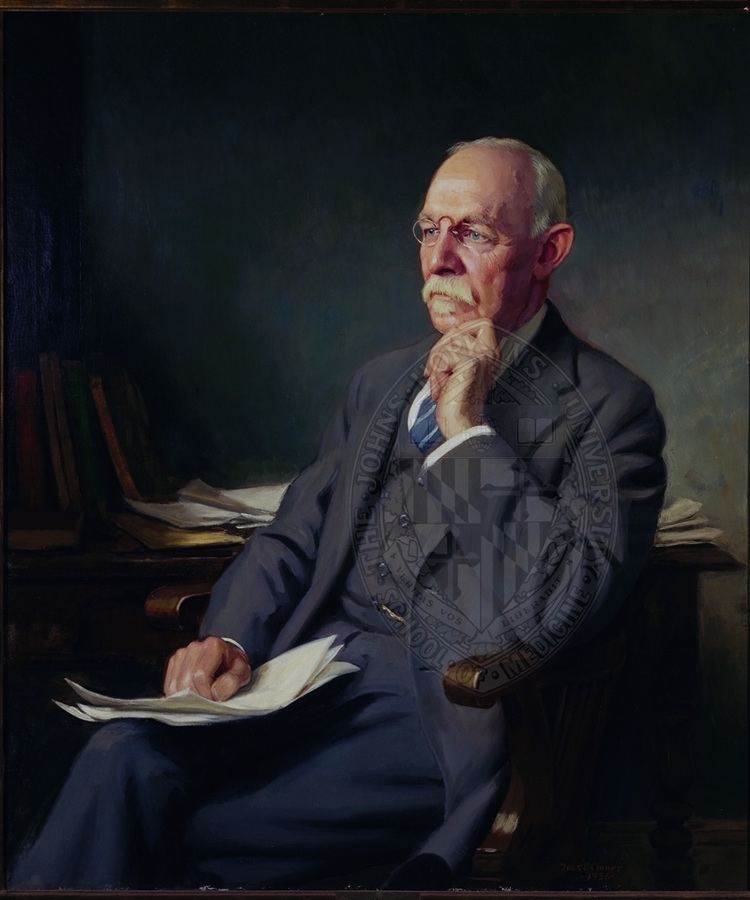Nationality United States Role Surgeon Fields Medicine | Influenced by Theodor Billroth Name William Halsted Books Surgical Papers | |
 | ||
Education Yale University, Columbia University College of Physicians and Surgeons, Columbia University Similar People Caroline Hampton, Theodor Billroth, Johannes Brahms | ||
William stewart halsted 1852 1922
William Stewart Halsted, M.D. (September 23, 1852 – September 7, 1922) was an American surgeon who emphasized strict aseptic technique during surgical procedures, was an early champion of newly discovered anesthetics, and introduced several new operations, including the radical mastectomy for breast cancer. Along with William Osler (Professor of Medicine), Howard Atwood Kelly (Professor of Gynecology) and William H. Welch (Professor of Pathology), Halsted was one of the "Big Four" founding professors at the Johns Hopkins Hospital. His operating room at Johns Hopkins Hospital is in Ward G, and was described as a small room where medical discoveries and miracles take place. According to an intern who once worked in Halsted's operating room, Halsted had unique techniques, operated on the patients with great confidence and often had perfect results which astonished the interns.
Contents
- William stewart halsted 1852 1922
- Visiting professor 2012 john l cameron md on william stewart halsted md
- Early life and education
- Medical career
- Eponyms
- References

Throughout his professional life, he was addicted to cocaine and later also to morphine, which were not illegal during his time. As revealed by his Hopkins colleague Osler's diary, Halsted developed a high level of drug tolerance for morphine. He was "never able to be reduce the amount to less than three grains daily". The addictions were a direct result of Halsted's use of himself as an experimental subject, in investigations on the effects of cocaine as an anesthetic agent.

Visiting professor 2012 john l cameron md on william stewart halsted md
Early life and education

William S. Halsted was born on September 23, 1852 in New York City. His mother was Mary Louisa Haines and his father William Mills Halsted, Jr. His father was a businessman with Halsted, Haines and Company. Halsted was educated at home by tutors until 1862, when he was sent to boarding school in Monson, Massachusetts. He didn't like his new school and even ran away at one point. He was later enrolled at Phillips Academy in Andover, Massachusetts, where he graduated in 1869. Halsted entered Yale College the following year. At Yale, Halsted was captain of the football team, played baseball and rowed on the crew team. Upon graduation from Yale in 1874, Halsted entered Columbia University College of Physicians and Surgeons. He graduated in 1877 with a Doctor of Medicine degree. Though raised a Presbyterian, Halsted was an agnostic by adulthood.
Medical career

After graduation, Halsted joined the New York Hospital as house physician, where he introduced the hospital chart which tracks the patient's temperature, pulse and respiration. It was at New York Hospital that Halsted met the pathologist William H. Welch, who would become his closest friend.
Halsted then went to Europe to study under the tutelage of several prominent surgeons and scientists, including Edoardo Bassini, Ernst von Bergmann, Theodor Billroth, Heinrich Braun, Hans Chiari, Friedrich von Esmarch, Albert von Kölliker, Jan Mikulicz-Radecki, Max Schede, Adolph Stöhr, Richard von Volkmann, Anton Wölfler, Emil Zuckerkandl.
Halsted returned to New York in 1880 and for the next six years led an extraordinarily vigorous and energetic life. He operated at multiple hospitals, including Roosevelt Hospital, the College of Physicians and Surgeons, Charity Hospital, Emigrant Hospital, Bellevue Hospital and Chambers Street Hospital. He was an extremely popular, inspiring and charismatic teacher. In 1882 he performed one of the first gallbladder operations in the United States, a cholecystotomy performed on his mother on the kitchen table at 2 am. Halsted also performed one of the first blood transfusions in the United States. He had been called to see his sister after she had given birth. He found her moribund from blood loss, and in a bold move withdrew his own blood, transfused his blood into his sister, and then operated on her to save her life.
In 1884, Halsted read a report by the Austrian ophthalmologist Karl Koller, describing the anesthetic power of cocaine when instilled on the surface of the eye. Halsted, his students, and fellow physicians experimented on each other, and demonstrated that cocaine could produce safe and effective local anesthesia when applied topically and when injected. In the process, Halsted became addicted to the drug. His close friend Harvey Firestone recognized the gravity of the situation, and arranged for Halsted to be abducted and put aboard a steamer headed for Europe. In the two weeks it took to complete the voyage, Halsted underwent an early, crude form of detoxification. Upon his return to the United States he became addicted again, and was sent to Butler Sanatorium in Providence, Rhode Island, where they attempted to cure his cocaine addiction with morphine. Although he remained dependent upon morphine for the remainder of his life, he continued his career as a pioneering surgeon; many of his innovations remain standard operating room procedures.
After his discharge from Butler in 1886, Halsted moved to Baltimore, Maryland to join his friend William Welch in organizing and launching the new Johns Hopkins Hospital. When it opened in May 1889, he became its first Chief of Surgery. In 1892, Halsted joined Welch, William Osler, and Howard Kelly in founding the Johns Hopkins School of Medicine, and was appointed its first Professor of Surgery.
Halsted was credited with starting the first formal surgical residency training program in the United States at Johns Hopkins. The program began with an internship of undefined length (individuals advanced once Halsted believed they were ready for the next level of training), followed by six years as an assistant resident, and then two years as house surgeon. Halsted trained many of the prominent academic surgeons of the time, including Harvey Williams Cushing and Walter Dandy, founders of the surgical subspecialty of neurosurgery; and Hugh H. Young, a founder of the specialty of urology.
He is also known for many other medical and surgical achievements. As one of the first proponents of hemostasis and investigators of wound healing, Halsted pioneered Halsted's principles, modern surgical principles of control of bleeding, accurate anatomical dissection, complete sterility, exact approximation of tissue in wound closures without excessive tightness, and gentle handling of tissues. In 1882 Halsted performed the first radical mastectomy for breast cancer in the U.S. at Roosevelt Hospital in New York; an operation first performed in France a century earlier by Bernard Peyrilhe (1735-1804). Other achievements included the introduction of the latex surgical glove and advances in thyroid, biliary tract, hernia, intestinal and arterial aneurysm surgery.
H.L. Mencken considered Halsted the greatest physician of the whole Johns Hopkins group, and Mencken’s praise of his achievements when he reviewed Dr. MacCallum's 1930 biography is a memorable tribute. “His contributions to surgery were numerous and various. He introduced the use of local anesthetics, he was the first to put on rubber gloves, and he devised many new and ingenious operations. But his chief service was rather more general, and hard to describe. It was to bring in a new and better way of regarding the patient. Antisepsis and asepsis, coming in when he was young, had turned the attention of surgeons to external and often extraneous things. Fighting germs, they tended to forget the concrete sick man on the table. Dr. Halsted changed all that. He showed that manhandled tissues, though they could not yell, could yet suffer and die. He studied the natural recuperative powers of the body, and showed how they could be made to help the patient. He stood against reckless slashing, and taught that a surgeon must walk very warily. Dr. William Mayo, one of the cofounders of the Mayo Clinic, once commented that Dr. Halsted took so long to perform procedures that the patients usually healed before he had a chance to close the incision. Though, like most men of his craft, he had no religion, he yet revived and reinforced the ancient saying of Ambroise Paré: ‘God cured him; I assisted.’ Above all, he was a superb teacher, though he never formally taught. The young men who went out from his operating room were magnificently trained, and are among the great ornaments of American surgery today.”
In 1890, Halsted married Caroline Hampton, the niece of Wade Hampton III, a former general in the Confederate States Army and also a former Governor of South Carolina. They purchased the High Hampton mountain retreat in North Carolina from Caroline's three aunts. There, Halsted raised dahlias and pursued his hobby of astronomy; he and his wife had no children. He died on September 7, 1922, 16 days short of his 70th birthday, from bronchopneumonia as a complication of surgery for gallstones and cholangitis.
